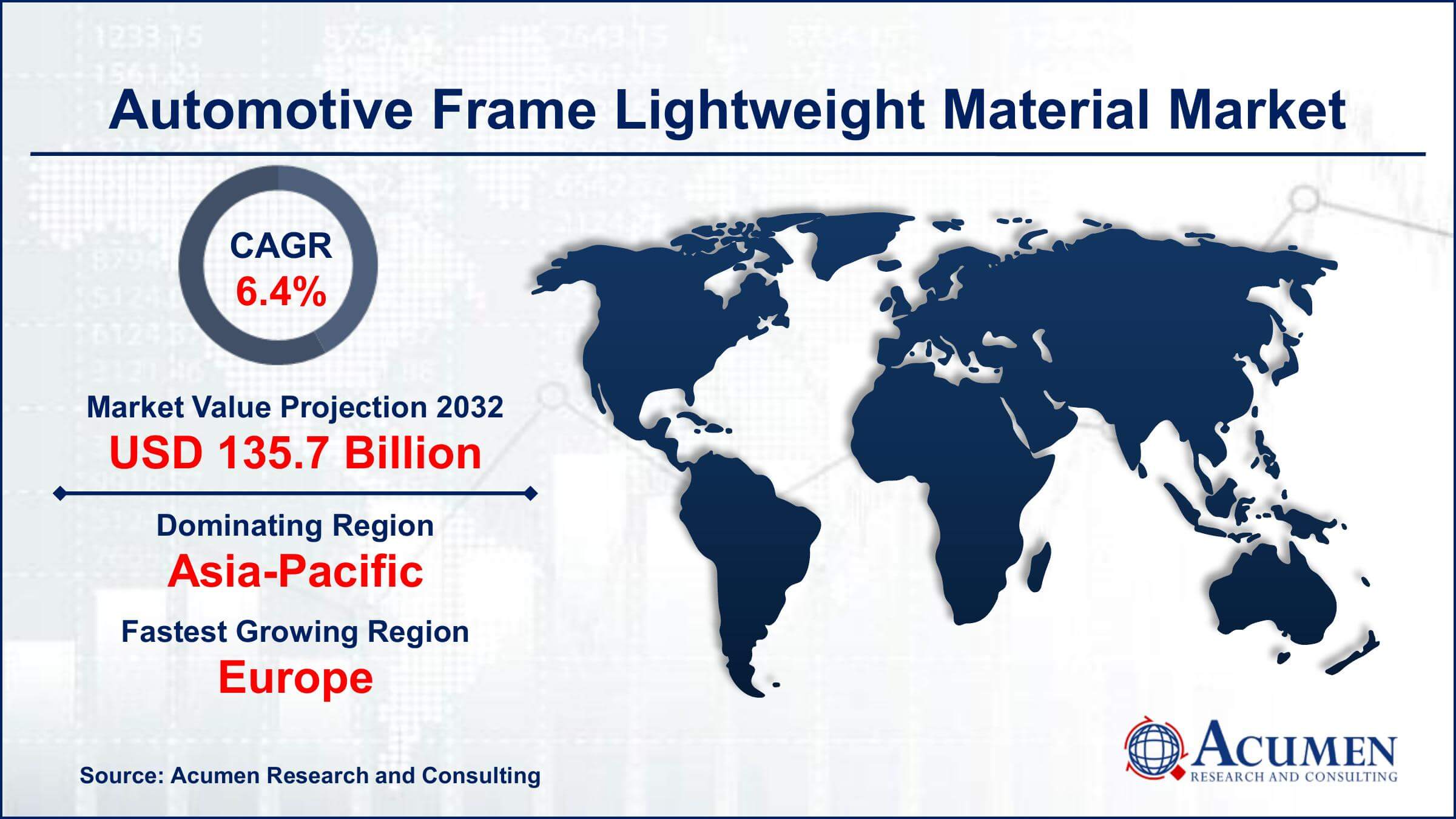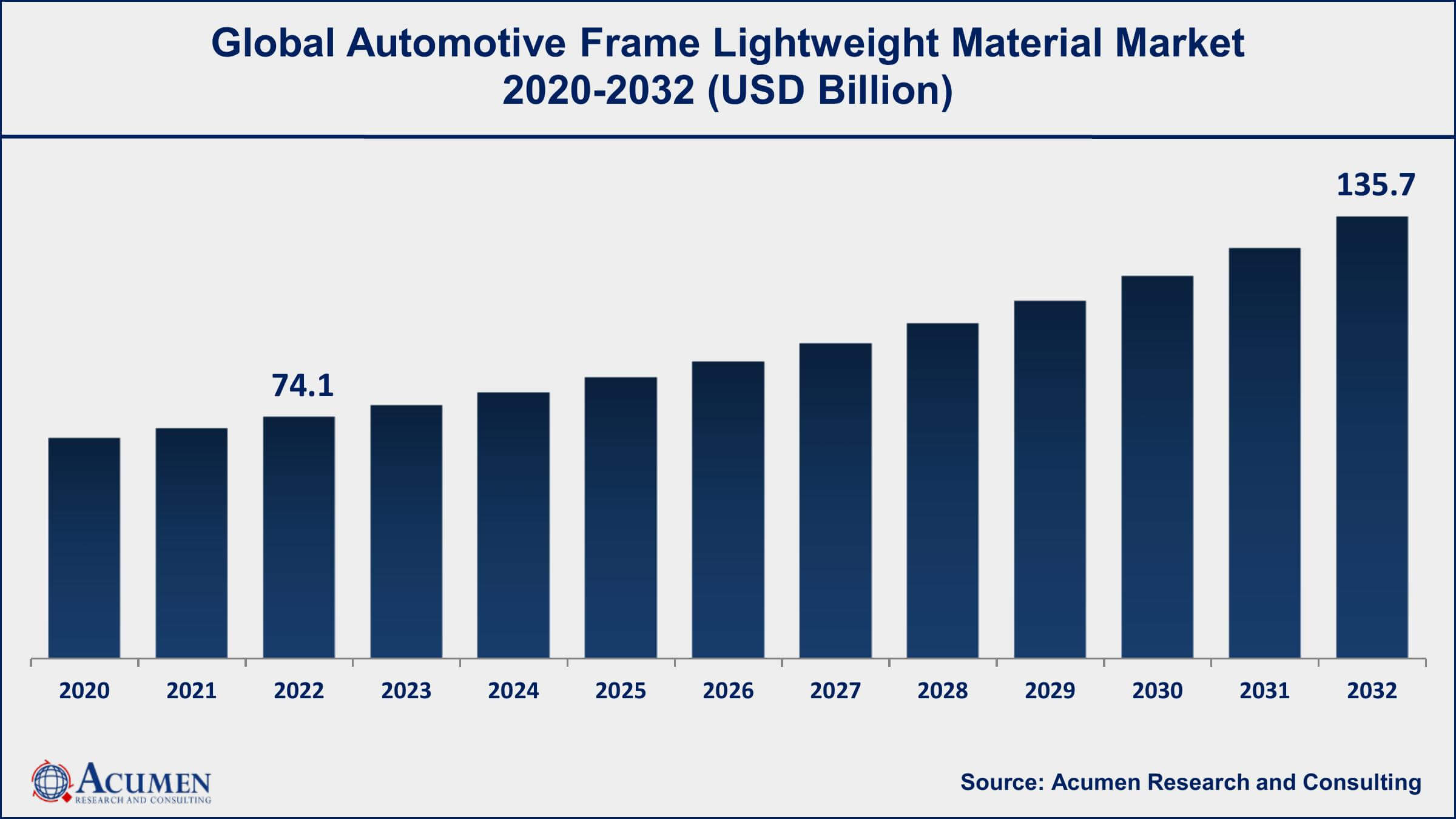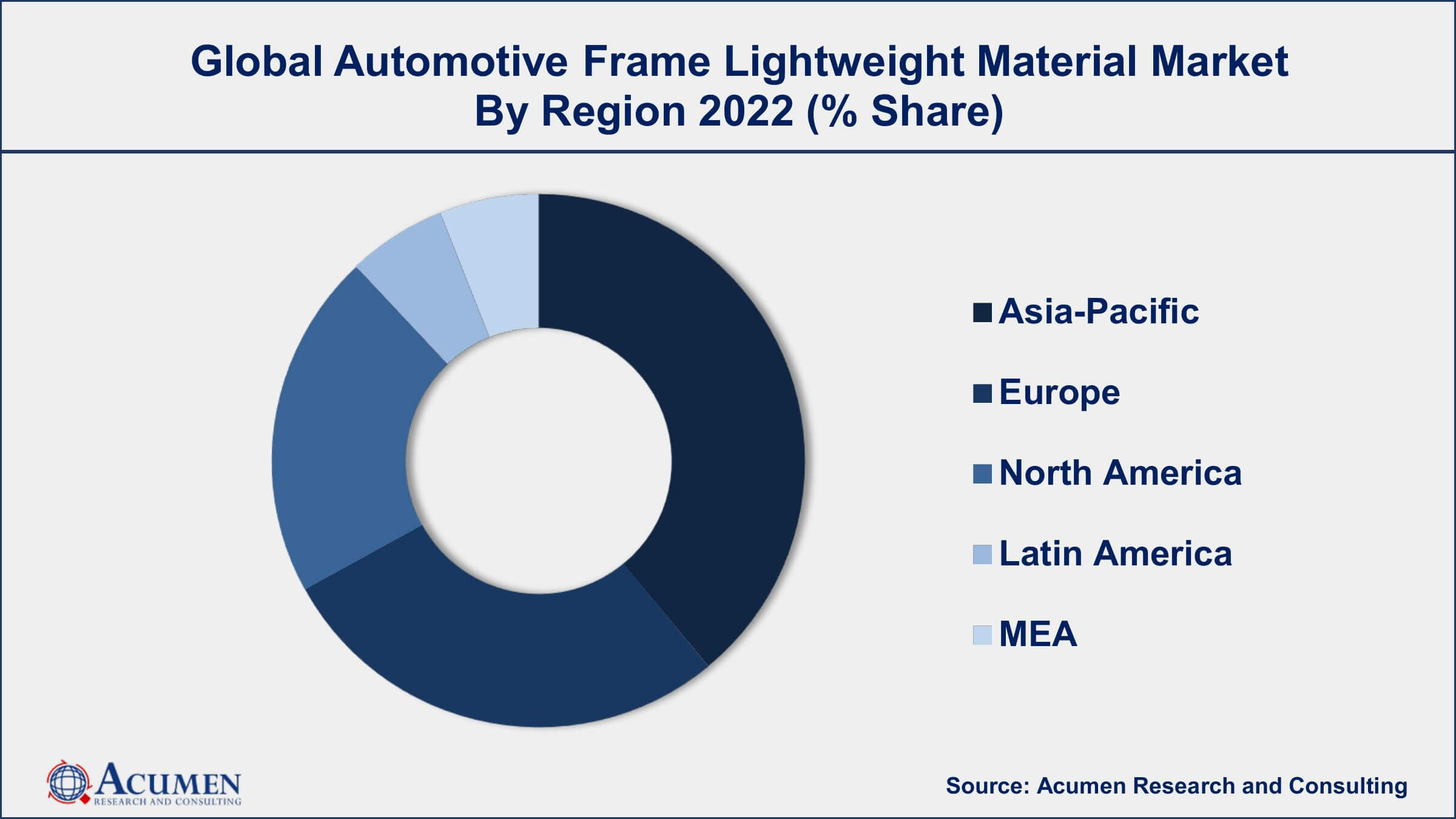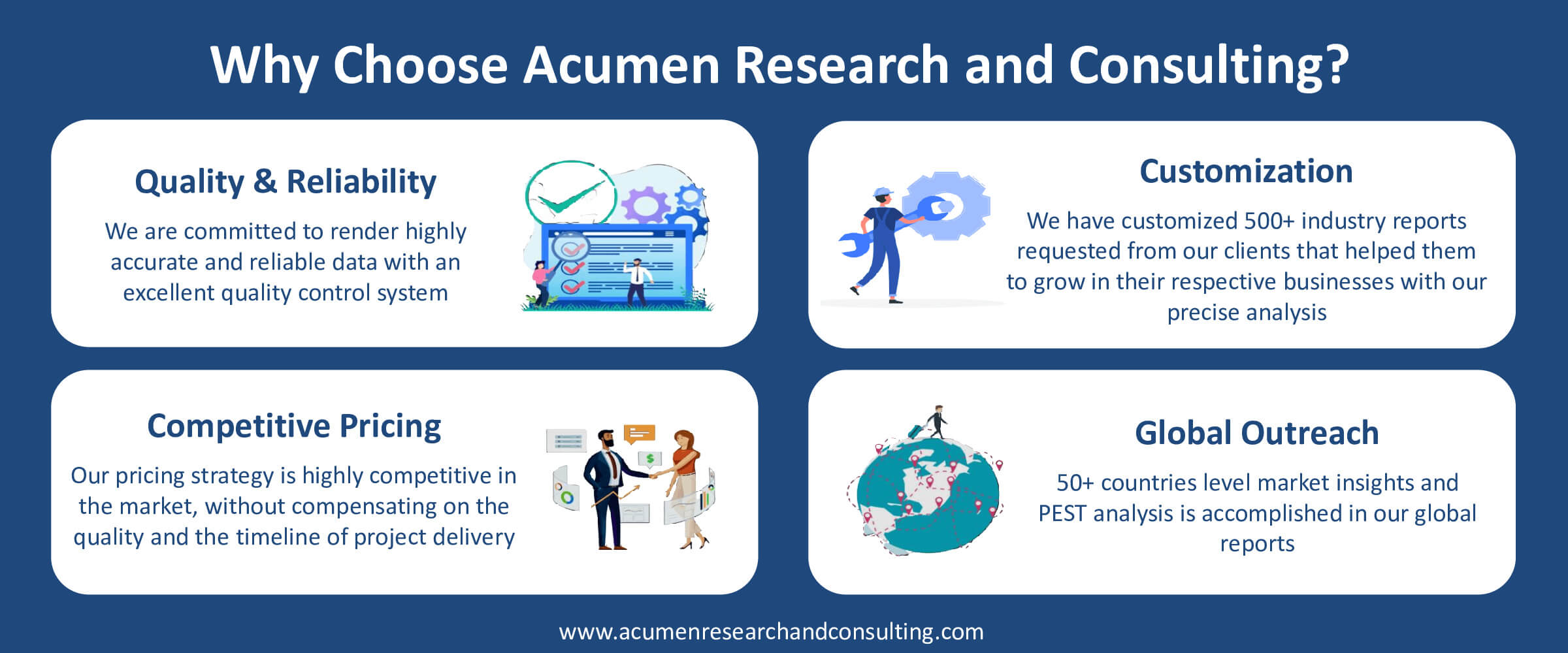April 2023
Market Size accounted for USD 74.1 Billion in 2022 and is projected to achieve a market size of USD 135.7 Billion by 2032 growing at a CAGR of 6.4% from 2023 to 2032.
The Global Automotive Frame Lightweight Material Market Size accounted for USD 74.1 Billion in 2022 and is projected to achieve a market size of USD 135.7 Billion by 2032 growing at a CAGR of 6.4% from 2023 to 2032.
Automotive Frame Lightweight Material Market Highlights

Automotive frame lightweight material refers to the use of advanced materials that are lighter and stronger than traditional materials like steel in the construction of automotive frames. These materials include aluminum, magnesium, carbon fiber composites, and high-strength steel alloys. The use of lightweight materials in automotive frames can significantly reduce the weight of the vehicle, improving fuel efficiency, performance, and safety.
The automotive frame lightweight material market has been growing rapidly in recent years, driven by the increasing demand for fuel-efficient and environmentally friendly vehicles. The growth of the market is attributed to factors such as the increasing demand for lightweight materials in electric vehicles, the implementation of stringent fuel efficiency and emission regulations by governments, and the growing focus on vehicle safety and performance. The automotive industry is undergoing a significant transformation, with automakers shifting towards electric and hybrid vehicles that require lightweight materials to achieve better range and performance. As a result, the demand for automotive frame lightweight materials is expected to continue growing in the coming years, presenting significant opportunities for companies operating in this market.

Global Automotive Frame Lightweight Material Market Trends
Market Drivers
Market Restraints
Market Opportunities
Automotive Frame Lightweight Material Market Report Coverage
| Market | Automotive Frame Lightweight Material Market |
| Automotive Frame Lightweight Material Market Size 2022 | USD 74.1 Billion |
| Automotive Frame Lightweight Material Market Forecast 2032 | USD 135.7 Billion |
| Automotive Frame Lightweight Material Market CAGR During 2023 - 2032 | 6.4% |
| Automotive Frame Lightweight Material Market Analysis Period | 2020 - 2032 |
| Automotive Frame Lightweight Material Market Base Year | 2022 |
| Automotive Frame Lightweight Material Market Forecast Data | 2023 - 2032 |
| Segments Covered | By Material Type, By Application, By Component, By Vehicle Type, And By Geography |
| Regional Scope | North America, Europe, Asia Pacific, Latin America, and Middle East & Africa |
| Key Companies Profiled | ArcelorMittal S.A., ThyssenKrupp AG, Novelis Inc., BASF SE, Norsk Hydro ASA, Alcoa Corporation, Toray Industries, Inc., Owens Corning, POSCO, AK Steel Holding Corporation, Kobe Steel Ltd., and Constellium SE. |
| Report Coverage |
Market Trends, Drivers, Restraints, Competitive Analysis, Player Profiling, Covid-19 Analysis, Regulation Analysis |
Advanced material plays an important role in improving the fuel proficiency of new vehicles along with confirming high safety and performance. Lightweight automobiles necessitate less energy in speeding up and surging vehicles’ efficacy compared to heavy vehicles and deliver lesser fuel consumption. Substituting cast steel and iron constituents with lightweight materials such as magnesium alloys, aluminum alloys, plastics, thermosetting composites and advanced high-strength steel (AHSS) helps to decrease the complete heaviness of an automobile's chassis.
Growing demand for less polluting vehicles and fuel-efficient automobiles, and stringent emission regulations are some of the major factors driving the growth of this market. However, the strength of the material is neglected at the time of manufacturing which can restrain the growth of this market. Growth in sales of electric automobiles is expected to boost the market growth in the near future. In addition, the acceptance of automotive frame lightweight material in different vehicle types is also expected to propel the growth of this market.
Automotive Frame Lightweight Material Market Segmentation
The global automotive frame lightweight material market segmentation is based on material type, application, component, vehicle type, and geography.
Automotive Frame Lightweight Material Market By Material Type
According to the automotive frame lightweight material industry analysis, the metals segment accounted for the largest market share in 2022. Metals, particularly aluminum and magnesium alloys, are some of the most commonly used materials in the market. These metals are lightweight, strong, and offer excellent corrosion resistance, making them ideal for use in the construction of automotive frames. The growing demand for lightweight vehicles and the need to meet stringent fuel efficiency and emission regulations are driving the growth of the metals segment. The use of advanced manufacturing processes such as hot forming, cold forming, and extrusion is also contributing to the growth of the metals segment in the automotive lightweight material market.
Automotive Frame Lightweight Material Market By Application
In terms of applications, the body-in-white segment is expected to witness significant growth in the coming years. The body-in-white refers to the assembly of a vehicle's structural components, including the frame, roof, doors, and floor. The use of lightweight materials in the body-in-white can significantly reduce the weight of the vehicle, improving its fuel efficiency, performance, and safety. The growing demand for fuel-efficient and electric vehicles is driving the growth of the body-in-white segment. The development of new lightweight materials and composites, as well as advanced manufacturing processes, is also driving the growth of the body-in-white segment in the automotive lightweight material market.
Automotive Frame Lightweight Material Market By Component
According to the automotive frame lightweight material market forecast, the frame segment is expected to witness significant growth in the coming years. The frame refers to the structural framework of the vehicle that supports the body and drivetrain components. The use of lightweight materials in the frame can significantly reduce the weight of the vehicle, improving its fuel efficiency, performance, and safety. The growing demand for fuel-efficient and electric vehicles, as well as the need to meet stringent fuel efficiency and emissions regulations, is driving the growth of the frame segment in the automotive lightweight material market. With the increasing demand for lightweight materials in the automotive industry, the frame segment is expected to continue growing in the coming years.
Automotive Frame Lightweight Material Market By Vehicle Type
Based on the vehicle type, the electric-powered segment is expected to continue its growth trajectory in the coming years. Electric vehicles (EVs) have gained significant popularity in recent years, driven by the need to reduce greenhouse gas emissions and improve air quality. Lightweight materials play a critical role in the design and construction of EVs, as they can help to offset the weight of heavy batteries and improve their driving range. The use of lightweight materials in the electric-powered segment is expected to be driven by the increasing demand for EVs and the need to improve their performance and efficiency. The development of new lightweight materials and composites, as well as advanced manufacturing processes, is also driving the growth of the electric powered segment.
Automotive Frame Lightweight Material Market Regional Outlook
North America
Europe
Asia-Pacific
Latin America
The Middle East & Africa

Automotive Frame Lightweight Material Market Regional Analysis
Asia-Pacific is currently the dominant region in the Automotive Frame Lightweight Material Market. The region is home to some of the world's largest automotive manufacturers and is a significant hub for the production and supply of lightweight materials. The growing demand for fuel-efficient and electric vehicles, as well as the need to meet stringent fuel efficiency and emissions regulations, is driving the growth of the automotive lightweight material market in the region. The increasing adoption of lightweight materials in the automotive industry, coupled with the presence of major automotive manufacturers, is driving the growth of the automotive frame lightweight material market in Asia-Pacific. The region's favorable government policies, such as subsidies for electric vehicles and investments in the development of advanced materials, are also driving the growth of the Asia-Pacific automotive frame lightweight material market.
Automotive Frame Lightweight Material Market Player
Some of the top automotive frame lightweight material market companies offered in the professional report include ArcelorMittal S.A., ThyssenKrupp AG, Novelis Inc., BASF SE, Norsk Hydro ASA, Alcoa Corporation, Toray Industries, Inc., Owens Corning, POSCO, AK Steel Holding Corporation, Kobe Steel Ltd., and Constellium SE.
Looking for discounts, bulk pricing, or custom solutions? Contact us today at sales@acumenresearchandconsulting.com
April 2023
April 2024
October 2024
May 2018